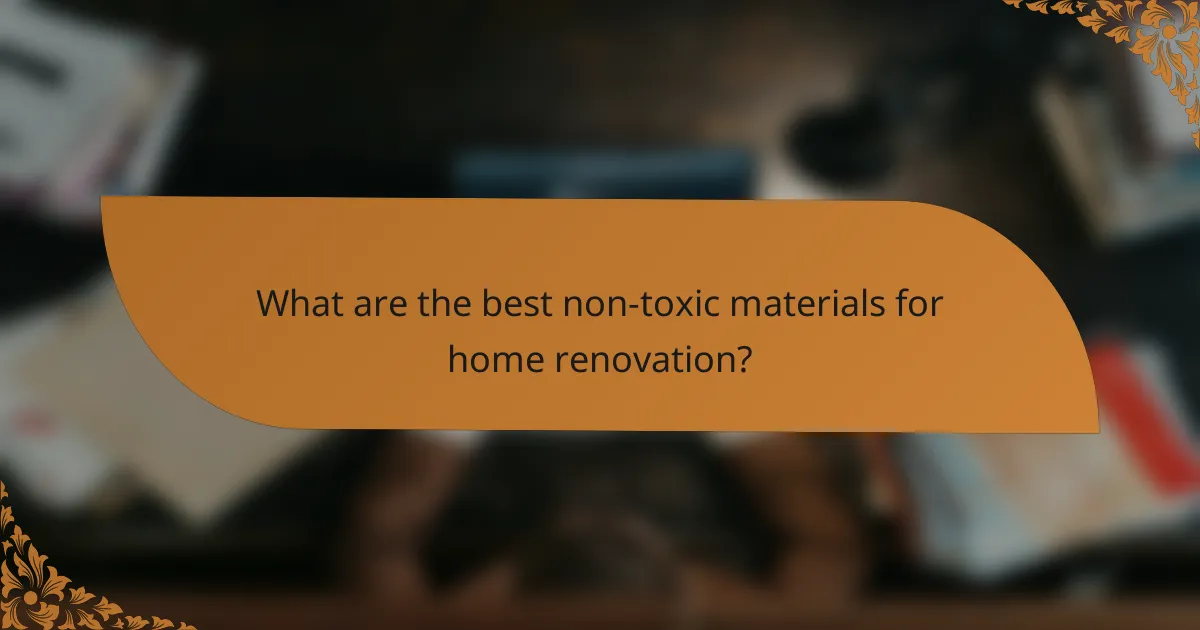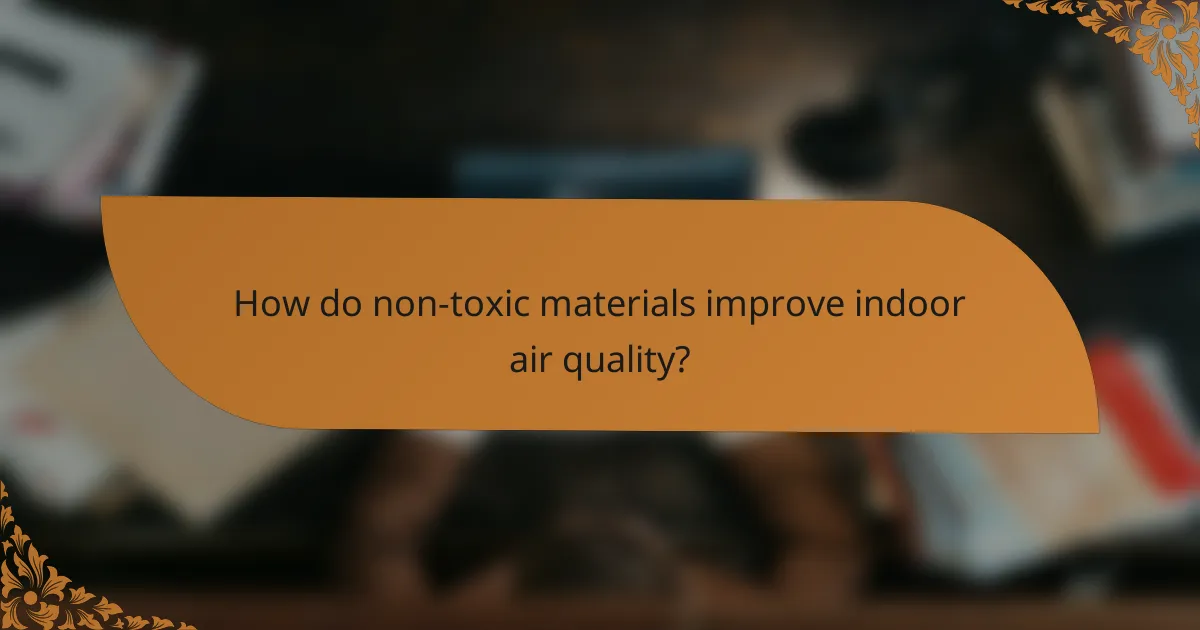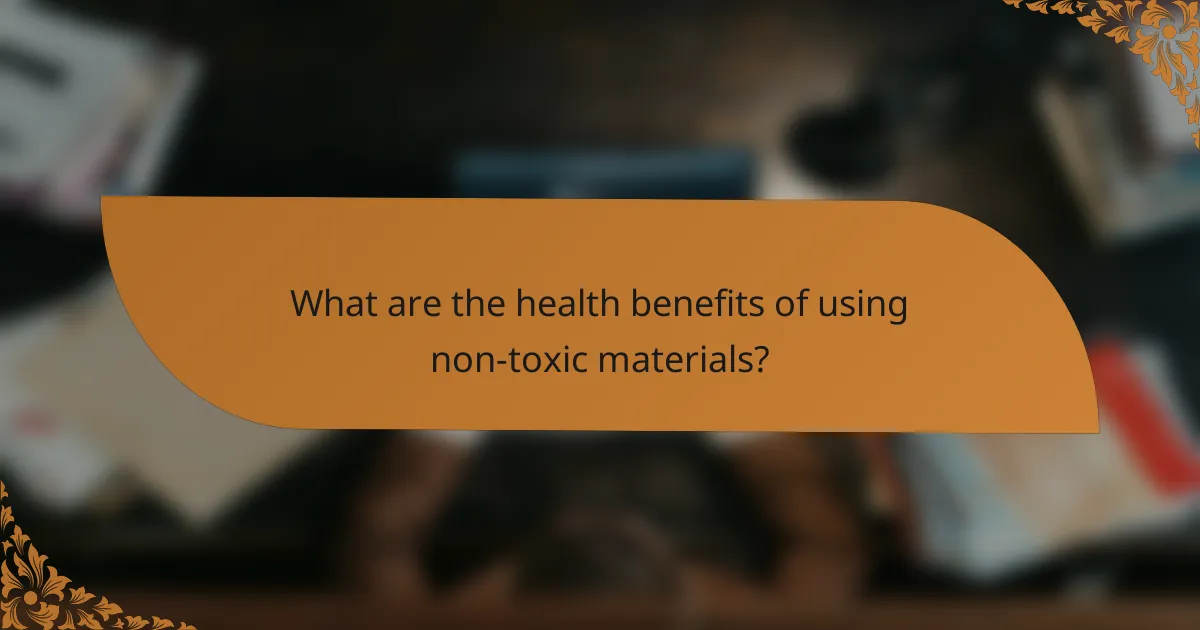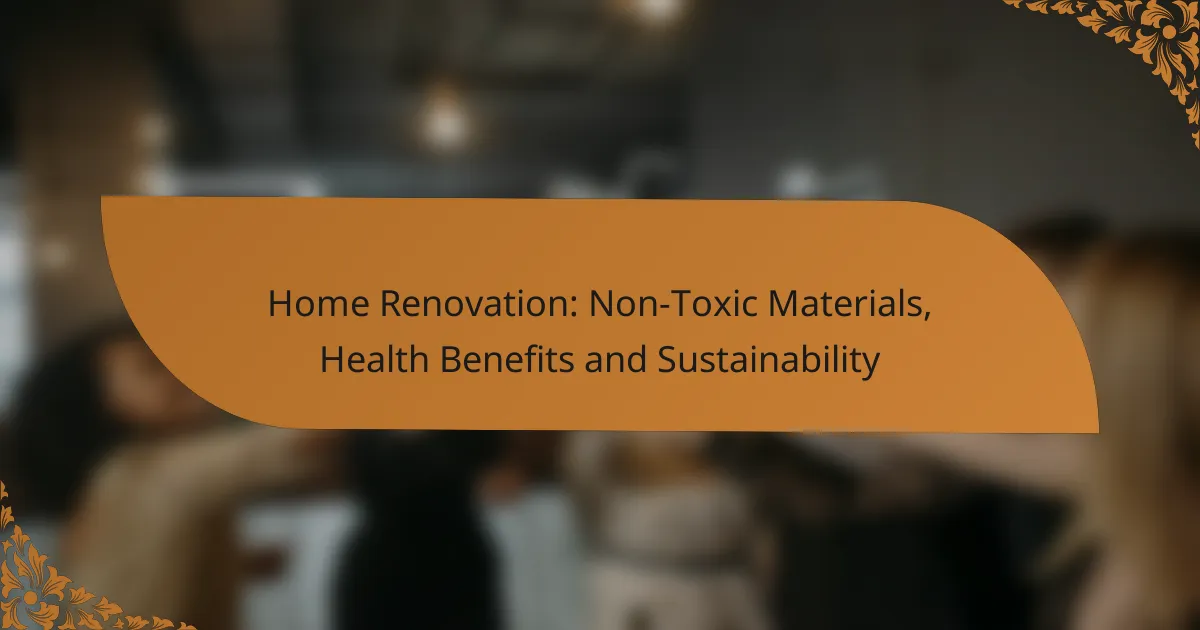Home renovation with non-toxic materials is essential for creating a healthier living environment while promoting sustainability. By choosing materials that minimize harmful chemical exposure, homeowners can enhance indoor air quality and reduce the risk of allergies. These eco-friendly options not only contribute to well-being but also support a cleaner, safer home for all inhabitants.

What are the best non-toxic materials for home renovation?
The best non-toxic materials for home renovation include options that minimize harmful chemical exposure while promoting sustainability. These materials not only enhance indoor air quality but also contribute to a healthier living environment.
Low-VOC paints
Low-VOC (volatile organic compounds) paints are designed to emit fewer harmful chemicals into the air compared to traditional paints. When selecting low-VOC options, look for products with VOC levels below 50 grams per liter, which are widely available in various colors and finishes.
Using low-VOC paints can significantly improve indoor air quality, making them ideal for spaces where children or sensitive individuals spend time. Always check for certifications like Green Seal or the EPA’s Safer Choice label to ensure compliance with health standards.
Natural flooring options
Natural flooring options such as bamboo, cork, and reclaimed wood are excellent choices for non-toxic home renovations. These materials are renewable, biodegradable, and often free from harmful chemicals found in synthetic flooring products.
When choosing natural flooring, consider factors like durability and maintenance. For instance, bamboo is highly durable and water-resistant, while cork provides excellent insulation and comfort underfoot. Ensure that any finishes or adhesives used are also non-toxic to maintain a healthy environment.
Eco-friendly insulation
Eco-friendly insulation materials, such as cellulose, sheep’s wool, and cotton, offer effective thermal performance without the harmful chemicals found in conventional insulation. Cellulose, made from recycled paper, is treated with non-toxic fire retardants, making it a sustainable choice.
When installing insulation, ensure proper sealing to prevent air leaks and maximize energy efficiency. Additionally, consider the R-value, which indicates thermal resistance; higher values mean better insulation performance. Aim for R-values that meet local building codes for optimal energy savings.
Recycled materials
Recycled materials, including reclaimed wood, recycled glass, and metal, are excellent for sustainable renovations. These materials reduce waste and the demand for new resources, making them environmentally friendly choices.
Incorporating recycled materials can add unique character to your home. For example, reclaimed wood beams can serve as stunning architectural features, while recycled glass tiles can create beautiful backsplashes. Always verify the source and processing methods to ensure they align with your non-toxic goals.
Non-toxic adhesives
Non-toxic adhesives are crucial for maintaining a healthy indoor environment during renovations. Look for products labeled as low-VOC or water-based, which typically contain fewer harmful chemicals than traditional adhesives.
When selecting adhesives, consider their intended use. For flooring, opt for adhesives specifically designed for that purpose, ensuring they provide strong bonding without compromising air quality. Always follow the manufacturer’s instructions for application and curing times to achieve the best results.

How do non-toxic materials improve indoor air quality?
Non-toxic materials enhance indoor air quality by minimizing harmful emissions and promoting a healthier living environment. These materials are designed to release fewer volatile organic compounds (VOCs) and other pollutants, leading to cleaner air and improved well-being.
Reduction of harmful emissions
Non-toxic materials significantly reduce harmful emissions that can contribute to indoor air pollution. For instance, traditional paints and finishes often contain VOCs, which can linger in the air long after application. In contrast, low-VOC or zero-VOC alternatives help maintain a healthier atmosphere.
Choosing non-toxic options, such as natural paints or adhesives, can lower the levels of harmful substances in your home. This is particularly important for families with children or individuals with respiratory issues, as it minimizes exposure to irritants.
Enhanced ventilation
Using non-toxic materials often goes hand-in-hand with improved ventilation strategies. When these materials are installed, they typically require better airflow to ensure that any residual emissions dissipate quickly. This can lead to a more breathable indoor environment.
Incorporating features like windows, vents, or air purifiers can further enhance ventilation. This combination not only helps to maintain air quality but also supports overall energy efficiency in the home.
Lower allergen levels
Non-toxic materials can help lower allergen levels in indoor spaces, making them more comfortable for sensitive individuals. Materials such as natural fibers and organic finishes are less likely to harbor dust mites, mold, and other allergens compared to conventional options.
Regular maintenance, such as cleaning and proper ventilation, can further reduce allergen accumulation. Opting for non-toxic furnishings and finishes is a proactive step towards creating a healthier living space, especially for those with allergies or asthma.

What are the health benefits of using non-toxic materials?
Using non-toxic materials in home renovation can significantly enhance health by reducing harmful exposures and promoting a safer living environment. These materials contribute to better air quality, lower risks of allergies, and overall improved well-being.
Improved respiratory health
Non-toxic materials, such as low-VOC paints and natural flooring options, can greatly improve respiratory health. Traditional materials often emit volatile organic compounds (VOCs) that can irritate the lungs and exacerbate conditions like asthma. By choosing non-toxic alternatives, you can create a healthier indoor air quality that supports easier breathing.
Consider using products certified by organizations like GREENGUARD or the Environmental Protection Agency (EPA) that ensure low emissions of harmful substances. This is particularly important in homes with children or individuals with pre-existing respiratory issues.
Reduced chemical exposure
Opting for non-toxic materials minimizes exposure to harmful chemicals commonly found in standard construction products. Many conventional materials contain harmful substances that can leach into the air or surfaces, posing health risks over time. Non-toxic options, such as organic paints and natural insulation, help mitigate these risks.
When selecting materials, look for labels that indicate they are free from harmful chemicals, such as formaldehyde and phthalates. This can be especially beneficial in kitchens and bathrooms, where moisture can exacerbate chemical off-gassing.
Better overall well-being
Using non-toxic materials not only protects physical health but also enhances mental well-being. Environments free from toxic substances can lead to reduced stress levels and improved mood. Natural materials often provide a more aesthetically pleasing and calming atmosphere, contributing to a sense of comfort in your home.
Incorporating plants and natural light alongside non-toxic materials can further enhance your living space. Consider integrating biophilic design principles, which emphasize connection to nature, to foster a healthier and more enjoyable home environment.

How does sustainability factor into home renovation?
Sustainability in home renovation involves using eco-friendly practices and materials to minimize environmental impact while enhancing living conditions. This approach not only conserves resources but also promotes health and well-being for occupants.
Use of renewable resources
Incorporating renewable resources is essential for sustainable home renovation. Materials such as bamboo, reclaimed wood, and recycled metal can significantly reduce the carbon footprint of a project. These resources are often sourced locally, which further decreases transportation emissions.
When selecting renewable materials, look for certifications like FSC (Forest Stewardship Council) for wood products. This ensures that the materials are harvested sustainably and responsibly.
Waste reduction strategies
Implementing waste reduction strategies is crucial in sustainable renovations. This can include reusing existing materials, donating usable items, and recycling construction debris. Aim to divert at least 50% of waste from landfills during your renovation.
Consider a deconstruction approach instead of demolition. This allows for the salvage of materials like bricks, fixtures, and cabinets, which can be reused in your project or sold to others.
Energy-efficient designs
Energy-efficient designs are a key component of sustainable home renovations. Features such as proper insulation, energy-efficient windows, and high-efficiency appliances can significantly reduce energy consumption. These upgrades not only lower utility bills but also enhance comfort.
When planning your renovation, consider integrating renewable energy sources like solar panels. While the initial investment can be substantial, the long-term savings and environmental benefits often outweigh the costs, especially with available incentives and rebates in many regions.

What are the costs associated with non-toxic renovations?
The costs of non-toxic renovations can vary significantly based on the materials chosen and the scope of the project. Generally, non-toxic materials may have a higher upfront cost compared to traditional options, but they offer long-term benefits that can offset these initial expenses.
Price comparison with traditional materials
Non-toxic materials often range from 10% to 30% more expensive than conventional building supplies. For example, low-VOC paints and natural flooring options like bamboo or cork can cost more upfront. However, the price difference can be justified by their durability and lower environmental impact.
When budgeting for renovations, consider both the initial costs and the potential lifespan of the materials. Investing in non-toxic options may lead to fewer replacements and repairs over time, which can save money in the long run.
Long-term savings on health
Using non-toxic materials can lead to significant long-term health savings by reducing exposure to harmful chemicals. Healthier indoor air quality can minimize medical expenses related to respiratory issues and allergies, potentially saving thousands of dollars over time.
Investing in non-toxic renovations can also enhance overall well-being, leading to fewer sick days and improved productivity. This indirect cost-saving aspect is often overlooked but is crucial for families and individuals concerned about health impacts.
Potential tax incentives
Many regions offer tax incentives for homeowners who choose eco-friendly and non-toxic renovation materials. These incentives can include rebates, credits, or deductions that help offset the initial costs of sustainable renovations.
Check local regulations or consult with a tax professional to understand available incentives in your area. Some programs may require specific certifications for materials, so ensure compliance to maximize your savings.
